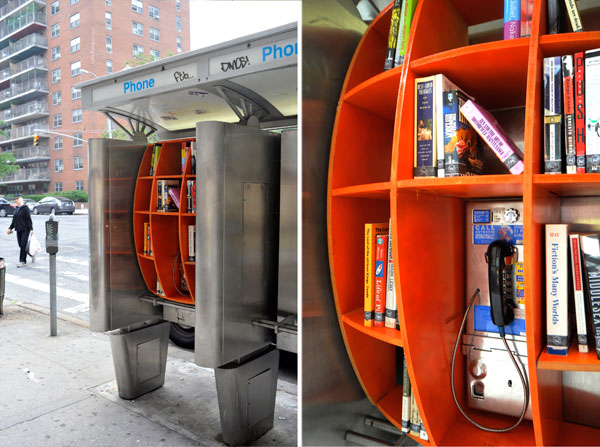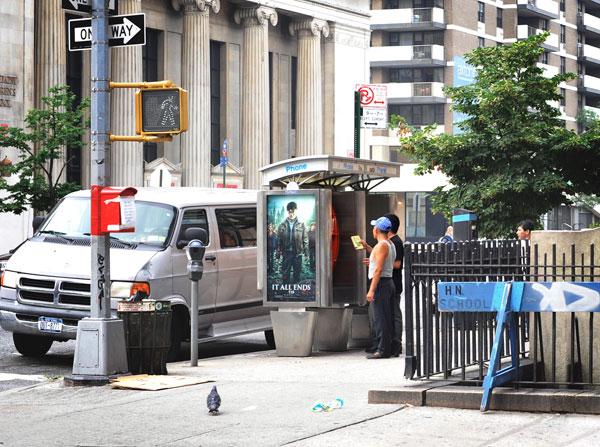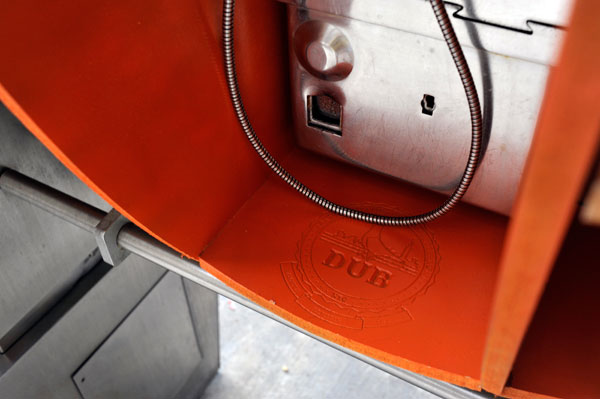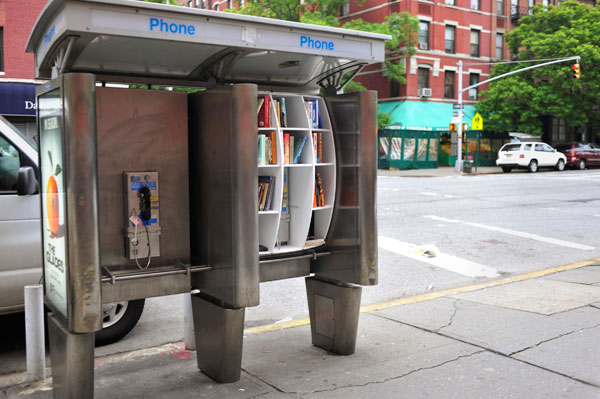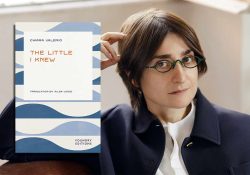Turning Urban Obsolescence into Community Connection: A Conversation with John Locke
Photos provided by John Locke
Technology’s unapologetic march toward a slimmer, sleeker, sexier experience—dominated, and prefixed with, an all-powerful i—has turned payphones into what New York architect John Locke calls “a detriment to the urban experience.” His solution involves another technology he says is on the cusp of obsolescence.
John Tyler Allen: How did the Department of Urban Betterment (DUB) begin, and what ideals drive and guide it?
John Locke: Basically the project, and DUB, began by identifying and trying to exploit potentially underused streetscape spaces. In other words, the first place I looked was the phone booths that litter my neighborhood. I consider the booths a detriment to the urban experience in that, spatially, they both reduce the available sidewalk width and they also occupy the street as pedestrian level billboards. And of course, in a world of ubiquitous mobile communication devices, their original function has disappeared. Most neighborhoods in lower Manhattan have very little phone booth coverage, but here, where I live in Morningside Heights, they are surprisingly common; some streets have as many as five booths on one block. So, the project really began with that idea of how can we turn something obsolete and a net negative for the neighborhood into something worthwhile that would hopefully encourage community involvement and provide a sense of connection with neighbors over something shared.
JTA: Was it important to you to choose a project centered around books?
JL: The idea of creating the project around books is just one solution to that question. As an avid reader and owner of way too many physical books, I was immediately drawn to that as being a potentially workable solution, and I personally believe that a world with more books in circulation is pretty nice. What’s more common than sharing a good book you’ve read with a friend? But at the same time, I can envision a number of other valid solutions. In Beijing phone booths have been converted into Internet hot spots, and in Austin a group of artists converted a payphone kiosk into a seesaw. But could they also function as other sorts of community communication devices, ways to locally transmit information and data? Those are the things I’m most interested in.
I was also drawn to the technological, and maybe even psychological, symmetry between physical books and phone booths. I think there is an innate feeling of loss toward both, in that one has already been rendered obsolete by a new technology—cellular phones—and the other is seemingly on the cusp of obsolescence as well, both through the proliferation of e-book readers and the general waning of literature as being part of the wider cultural discussion. And I think there is always a sense of hesitation, maybe even nostalgia, when something that once seemed so prominent and important begins to disappear.
JTA: Have you seen the UK phone boxes and other public spaces that have played host to community libraries? Did any other mini-libraries serve as inspiration for this project?
JL: Yeah, a number of people sent links to information about the UK phone boxes. I think they’re great, it’s really cool to work with something as iconic as the red phone booth. And I certainly appreciate and am inspired anytime someone takes it upon themselves to improve urban space.
JTA: How did the surrounding communities respond to the bookshelves?
JL: Well of course, each block in New York is totally different from the last, so the communities of the two booths were not the same even though they were only separated by about ten blocks. There are a number of subjective qualities to the streetscape that can affect how people react to something like these mini-libraries, such as retail storefronts, street traffic, proximity to public transportation, etc. The first iteration was located in a seemingly abandoned stretch of street, a place with little pedestrian traffic or local businesses. It was near a hostel, which I thought would help, but I think the transient nature of that population, coupled with the overall lack of neighborhood amenities, gave the site a deserted feel and led to the books quickly being removed and, I would assume, resold. The second booth, however, was located near a train station with a high volume of pedestrian traffic as well as being closer to high-rise apartment buildings. I saw that in the results, where it was used and books were left as well as taken.
JTA: What did you learn from the first two installations that you’re implementing for the third?
JL: Pragmatically, I learned that I need to alter the design if I don’t want the phone company to remove the shelves. They need to access the guts of the actual phone for maintenance, and the design needs to allow them the movement and access they need to do their job without these mini-libraries getting in their way.
I think the next iterations will be a little bit more prescriptive in presenting directions to people so that the purpose is made more clear, both in terms of taking a book and sharing/leaving their own books. As I saw with the second version, some people seemed hesitant to take a book with them—it wasn’t readily apparent what they were there for. Maybe the notion of a gift, or something for nothing, in public space is such a foreign concept, so outside the realm of what people expect, that it needs to be made more explicit that this project isn’t asking anything of you and can be ignored or enjoyed.
For a next step, I’d like to find any local businesses that would be interested in having a converted booth in front of their storefront, with the intention that they could potentially adopt the mini-library and help take care of upkeep.
JTA: The culture of each New York City neighborhood is vastly different. Do you have any predictions as to which neighborhoods would prove most accommodating to the installations? I hear Bryant Park and some brownstone steps (in the West Village and Brooklyn) have seen successful book swapping.
JL: I don’t know Bryant Park and brownstone Brooklyn nearly as well as I do my own neighborhood. If I lived in either of those places, I probably would have approached my central question—how to identify a quality of the urban condition that includes the latent capability for improvement—from an entirely different angle. There would be a number of various potentialities to explore in a place with such a transient population of tourists and office workers as that around the Bryant Park area, just as there would be a completely different set of rules around the leafy residential neighborhoods of Brooklyn Heights or Park Slope. I know Bryant Park has a hugely successful lending library associated with the NYC public library, and I imagine there are a number of cafés and bookstores that lend books in Brooklyn, but we don’t have that in my neighborhood; we do have a lot of phone booths, though. That’s why when I originally conceived of this project, I imagined it would spread north into Hamilton and Washington Heights, not into lower Manhattan.
JTA: The online presence of the project is littered with predictions of vandalism and theft. Are these constant predictions bothering you? What are your thoughts on bettering a society that refuses to believe change is possible?
JL: Of course it doesn’t bother me. I had the very same worries, but I guess I would be a pretty poor designer if I had an idea and failed to follow through because I was overly worried about one possible outcome. The fact is I had no idea what would happen, but I was really curious to see what happens when you put something like that out there, into the messy reality of urban space. I could only hope that the project would appeal to people’s better natures. But I’m really proud that the project provokes a reaction and starts a conversation, of which I don’t know the end, but it’s exciting to watch it develop.
JTA: What’s next for the payphone library? What’s next for DUB?
JL: I plan to continue testing and iterating versions to see what works best to promote community engagement. I've been in touch with an inspiring number of motivated individuals from a broad cross-section of disciplines who’d like to do something—anything—to get involved in urban betterment issues. Like us, they believe that through collaboration and sensitive interventions in urban space, we have the potential to change the world for the better.
JTA: Anything else we should know?
JL: I just finished teaching a course at Columbia titled “Hacking the Urban Experience,” where the students set out to re-appropriate and re-imagine how existing urban conditions could be improved. The students designed and fabricated working prototypes that had to embrace the complex reality of New York and attempt to promote community involvement. One particularly successful project installed an inflatable canopy, comprised of over four hundred balloons, underneath a scaffolding in a neglected area of upper Manhattan. The balloons glowed from inside creating a colorful, playful atmosphere that turned something typically associated with lack of light and space—the area under construction scaffolding—into a destination, an exciting, unexpected environment.
May 2012
"The Pop-up Libraries of Manhattan," are featured in the July 2012 Outpost in the print edition of WLT. For more on unusual libraries around the world, see our web exclusive "10 Unusual Micro Libraries" and contribute your own discoveries!
